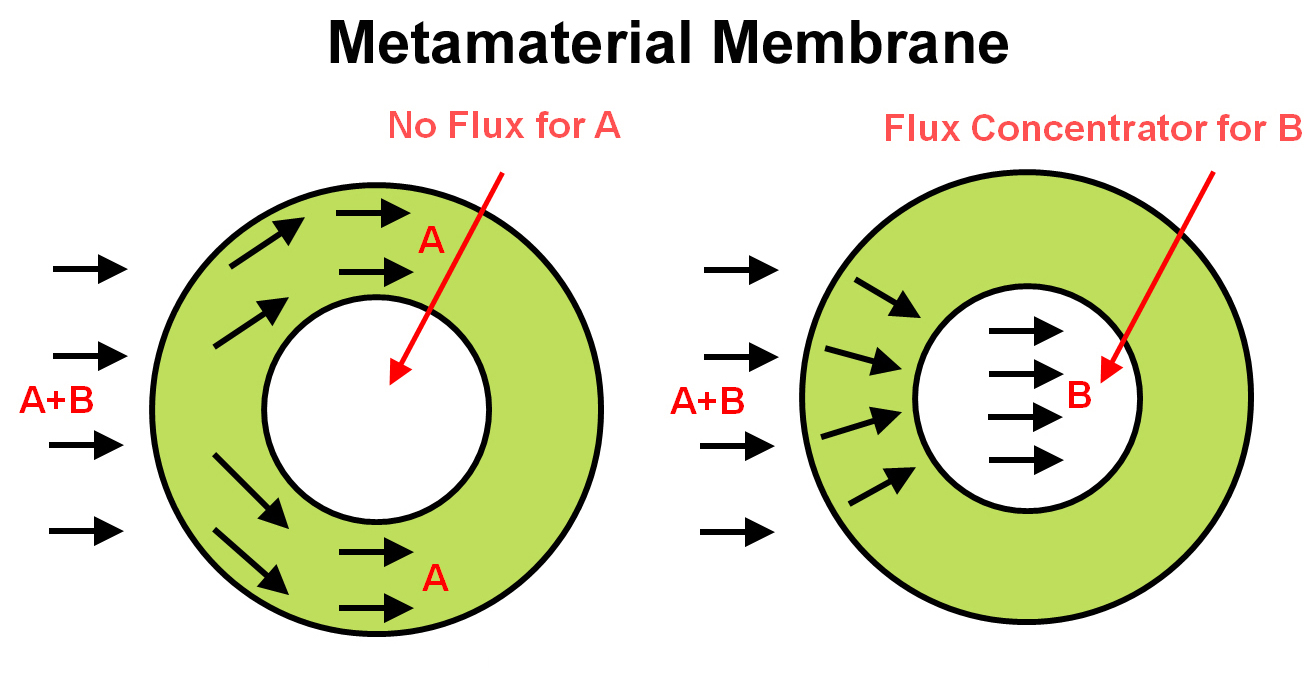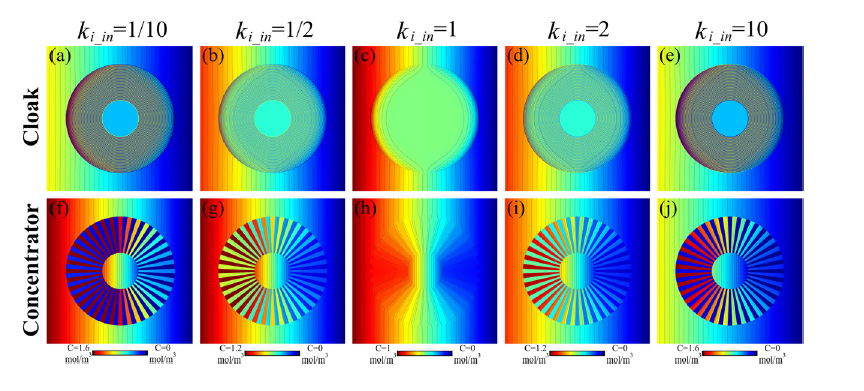Reports: DNI1056211-DNI10: Metamaterial Membranes for Separation of Chemical Mixtures
Martin Maldovan, Georgia Institute of Technology
Metamaterials are structured materials designed to have properties not achieved in conventional materials. Metamaterials are generally complex architectures involving anisotropic and non- homogeneous materials that must be theoretically designed prior to their physical realization.
Materials of this kind that control light, sound, and heat on mesoscales have been previously demonstrated. However, understanding and design of metamaterials that can manipulate mass- flow has been much less developed. In many industrial chemical processes, combined operations of chemical reactors and separation trains are required. The long term goal of this research is to understand and design metamaterials with the purpose of developing a radically new approach to control mass-transfer. This research will create novel tools to develop separation processes in chemical plants. The realization of such materials would open many applications in chemical processing and separations where manipulation of mass flow is critical. In particular, one of the objectives was to develop and implement theoretical/computational methods for mass transfer in order to achieve metamaterial effects on mass flow and apply these methods to achieve a new principle to perform membrane-based separations.
Impact on PI’s career: The funding provided by ACS-PRF helped the PI to start a new line of research and to develop a new understanding and control of mass diffusion processes with the aim to design new techniques for separation processes. Based on the results obtained (4 publi- cations), the PI has now started a new experimental phase which can further advance his research portfolio.
Impact on students: The funding provided by ACS-PRF helped to support students who are pursuing a PhD degree. In addition to developing their careers, the research has led to four publications (see below) and multiple oral presentations at top conferences in the USA (e.g. MRS-Materials Research Society, APS-American Physical Society, and META-Metamaterial International Conference).
Publication 1: Mass Separation by Metamaterials Scientific Reports, Volume 6, Article Number 21971
Intro: Being able to manipulate mass flow is critically important in a variety of physical processes in chemical and biomolecular science. For example, separation and catalytic systems, which requires precise control of mass diffusion, are crucial in the manufacturing of chemicals,
crystal growth of semiconductors, waste recovery of biological solutes or chemicals, and production of artificial kidneys.
Results: We introduced a novel approach to obtain mass separation based on metamaterials that can sort chemical and biomolecular species by cloaking one compound while concentrating the other. We presented a practical case where a mixture of oxygen and nitrogen is manipulated using a metamaterial that cloaks nitrogen and concentrates oxygen. This work lays the foundation for molecular mass separation in biophysical and chemical systems through metamaterial devices.
Figure. (Left). Concentration profiles for cloaked compound A at different times. (a–e), Background (f–j) Anisotropic homogeneous cloak. (k–o) Multilayer cloaking device. B (Right). Concentration profiles for concentrated compound B. (a–e), Background. (f–j) Anisotropic homogeneous concentrator. (k–o) Multilayer concentrator device.
Publication 2: Rational design of mass diffusion metamaterial concentrators based on coordinate transformations Journal of Applied Physics, Volume: 120, Issue: 8, Article Number: 084902
Intro: Recent advances in coordinate transformations of Fick’s equation have paved the way for the design of metamaterial devices that can manipulate mass diffusion flux. The control of diffusion paths has a great potential for the design of novel catalytic and separation systems in chemical and biomolecular engineering.
Results: We presented a comprehensive study on the impact of structure and material properties on the physical properties of mass concentrator metamaterial shells. The concentration gradient at the core, the total mass flow rate towards the core, and the disturbance of the external concentration field were examined to provide guidelines for the rational design and fabrication of metamaterial mass concentrators. A practical case is also presented where the concentration of oxygen diffusing in a polymeric system is studied.
Figure. (a) Color map describing the mass concentration of oxygen in a polymeric metamaterial concentrator. (b) Concentration of oxygen along the centerline of the concentrator.
Publication 3: Metamaterial membranes Journal of Physics D-Applied Physics, Volume: 50, Issue: 2, Article Number: 025104
Results: We introduced a new class of metamaterial device to achieve separation of compounds by using coordinate transformations and metamaterial theory. By rationally designing the spatial anisotropy for mass diffusion, we simultaneously concentrate different compounds in different spatial locations, leading to separation of mixtures across a metamaterial membrane. We presented a practical case where a mixture of oxygen and nitrogen diffusing through a polymeric planar matrix was separated. This work opens doors to new paradigms in membrane separations via coordinate transformations and metamaterials by introducing novel properties and unconventional mass diffusion phenomena.
Figure. Color maps for the steady-state concentration of (a) O2 and (b) N2. (c) Selectivity for
the metamaterial membrane as a function of sampling area (red bars) and for membranes made of pure homogeneous materials M1, M2, M3, M4 and background medium (blue bars).
Publication 4: Mass diffusion cloaking and focusing with metamaterials Applied Physics Letters, Volume: 111, Issue: 7, Article Number: 071903
Intro: Recent advances in the design of metamaterials that control diffusive transport processes have enabled efficient devices to manipulate heat conduction. In contrast, control of mass diffusion with metamaterial devices has been largely unexplored. Mass diffusion is critically important in multiple research areas ranging from electronic and energy materials to chemical and biological systems.
Results: We introduced a physical approach to design mass diffusion metamaterial devices that take into account the fundamental physical mechanisms behind mass transport. We demonstrated that mass concentration discontinuities arising from different material solubilities are critical physical factors that need to be incorporated for the accurate design and characterization of mass diffusion metamaterial devices. We employed our approach to devise and analyze cloaking and focusing of molecules and show how the difference in solubilities is critically important for the efficiency of the metamaterials. This work provides physical insights and guidelines to understand and design mass diffusion in metamaterial devices.
Figure. Concentration profiles in layered metamaterials designed for different internal partition coefficients k_in. (a)–(e) Cloaks. (f)–(j) Concentrators.
Our work on metamaterials for separation has been in the NEWS:
Metamaterial Separation Proposed for Chemical, Biomolecular Uses http://www.news.gatech.edu/2016/03/02/metamaterial-separation-proposed-chemical- biomolecular-uses
















